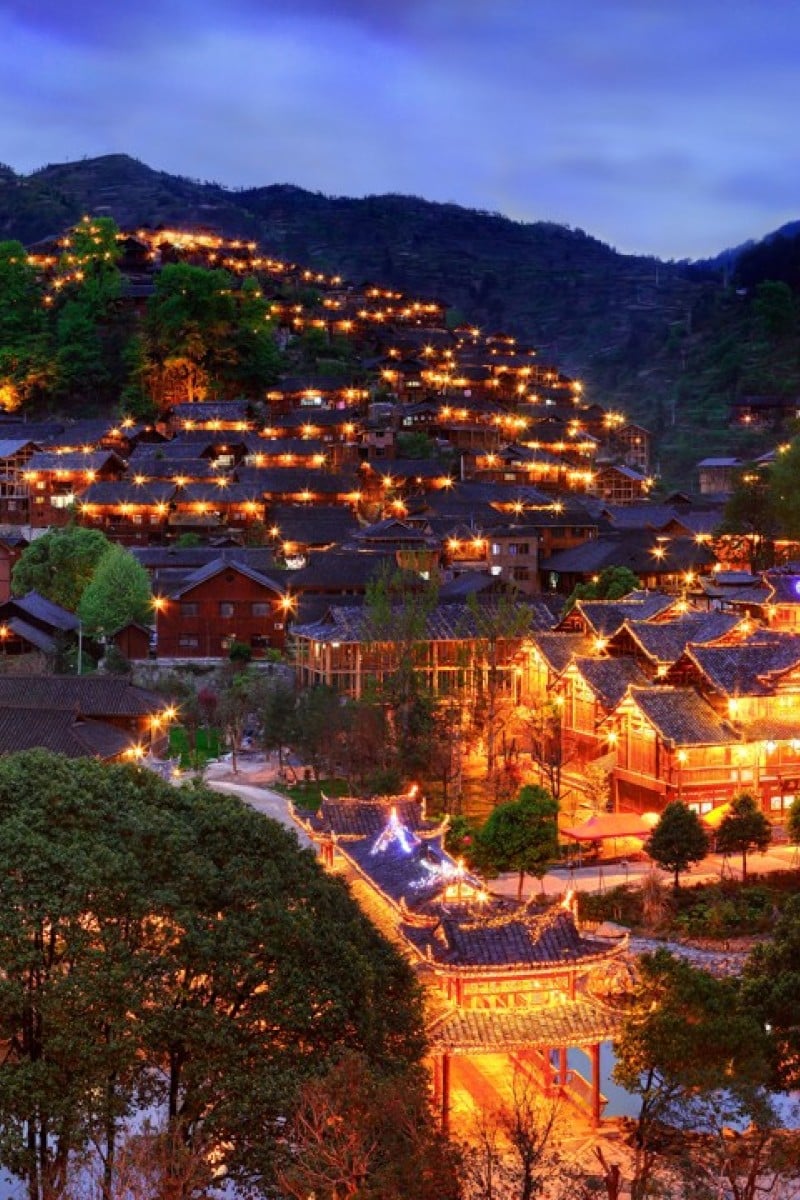
Check in China: Unesco World Heritage site Guizhou is rich in history, wildlife, natural marvels, and thrilling adventures
With spectacular mountains, caves, and perfectly preserved cultures, Guizhou is China’s best-kept secret
 Xijiang’s villages, surrounded by mountains, offer a spectacular sight when they are lit up at night.
Xijiang’s villages, surrounded by mountains, offer a spectacular sight when they are lit up at night.China boasts more Unesco World Heritage sites than any other country in Asia. The site most recently listed sits in the south-western province of Guizhou, home to impressive mountains and more than 18 ethnic minority groups including Miao and Dong. From natural scenery to unique cultures, here’s what you can discover in Guizhou.
Fanjingshan
Mount Fanjing became the 53rd Chinese site on the Unesco World Heritage list earlier this year. “Fanjing” is short for Fantian Jingtu, which means “Brahma’s Pure Land”, highlighting the mountain’s sacred status in Buddhism. Fanjing is also home to an array of wildlife, including at least 50 endangered plant and animal species.
If that’s not enough reason to make a trip, try challenging yourself to hike up to the peaks and get blown away by the unparalleled views from the famed summit. At the Golden Summit, there are two peaks, each one topped with a temple and connected by a bridge.
Huangguoshu Waterfall
Plunging 70 metres and spanning 101 metres, China’s most beautiful waterfall is also one of the world’s highest. If you’re a Journey to the West fan and ever wondered where you can find Sun Wukong’s water curtain cave, this is where you need to be. We can’t promise that you’ll find the monkeys in the 134-metre-long cave behind the fall, but you’ll definitely get a great close-up look at the waterfall.
Don’t forget to bring your camera and get creative.
Check in China: Travel to scenic Yangshuo county for a relaxing holiday with sun and sports
Tianlong Tunpu
This well-preserved castle village is not far from the waterfall but it’ll take you 600 years into the past. Soldiers of Han ethnicity were posted here during the Ming dynasty and their descendants continue to live in the stone castles – with their costumes and customs unchanged. The local women are known for their blue robes with embroidered hems and you can see their traditional Dixi opera, or “ground opera”, performances.
Xijiang Thousand Miao Villages
Xijiang’s 12 ancient villages, nestled in the mountains and home to 6,000 people, make for a spectacular sight when they are lit up at night.
As the place with China’s largest Miao community, Xijiang is a living museum of Miao culture, and is sure to both surprise and fascinate.
Check in China: Make the most of your visit to Xi'an, the city of history, culture, and food
If you have time
Other must-sees in Guizhou include Libo Karst, a Unesco-listed karst landscape; Shuanghe Cave, Asia’s longest cave; Zunyi, a small city that changed the course of modern Chinese history by holding a Red Army meeting in the 1930s; and Oriental Science Fiction Valley, a VR theme park in the provincial capital of Guiyang.
How to get there
Hop on a flight to Guiyang and take it from there.
Alternatively, the high-speed train from Shenzhen is more affordable, though the train ride takes around five hours.
Before you go
No matter what time of the year you visit, don’t forget to pack warm clothes, especially when you go exploring the caves. The average temperature in summer is well below 30°C.
There is a local saying that you’ll never get really sunny days in a row in Guizhou. It gets cloudy and rainy a lot, so prepare umbrellas and raincoats. You’ll also be doing a lot of hiking, so make sure you wear comfortable shoes.
Be on the lookout for mosquitoes and other pesky insects, and be generous when applying repellents.
